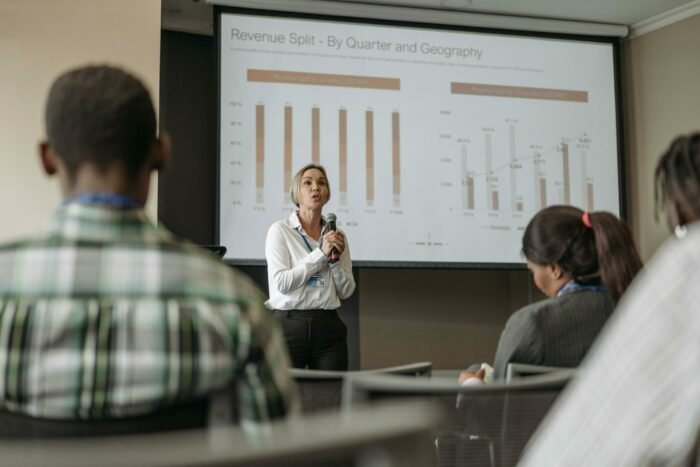As a leader, I understand the importance of personalized coaching sessions and individualized mentorship. One of the most powerful tools at my disposal is conducting high impact 1-on-1s with my team members. These one-on-one feedback sessions provide invaluable opportunities for tailored development programs and professional growth sessions.
High impact 1-on-1s are not just routine meetings; they are personalized coaching sessions that have the power to transform team dynamics and unlock the full potential of each individual. By investing time and effort in these sessions, I can foster team engagement, trust-building, and strategic thinking.
Preparation is key when it comes to mastering high impact 1-on-1s. Setting a clear agenda and understanding the impact of these sessions beyond the meeting room is crucial for success. Active listening and flexibility during the meetings further enhance their effectiveness. Seeking feedback and continuously adapting my approach are essential for continuous improvement. And the impact of high impact 1-on-1s extends far beyond the immediate meeting, creating a positive work environment conducive to team success and individual growth.
Mastering High Impact 1-on-1s for Leadership Success
Key Takeaways:
- High impact 1-on-1s provide personalized coaching sessions and individualized mentorship.
- These sessions go beyond routine meetings to foster team engagement and trust-building.
- Preparation, active listening, and flexibility are vital during high impact 1-on-1s.
- Continuous improvement through feedback and adaptability is key.
- The impact of high impact 1-on-1s extends beyond the meeting room to create a positive work environment.
Making 1-on-1s More Than Just Meetings
High impact 1-on-1s are not just calendar events; they are powerful catalysts for team engagement, trust-building, and strategic thinking. Whether you’re a seasoned leader or just starting your leadership journey, mastering the art of 1-on-1 meetings can revolutionize your approach to leadership and transform team dynamics. By setting clear agendas, choosing the right frequency and location, and making each team member feel heard, valued, and understood, you can turn 1-on-1s into meaningful growth opportunities.
“High impact 1-on-1s are the foundation for building strong relationships with your team members. They provide a dedicated space for personalized coaching sessions and enable leaders to understand their team’s strengths, weaknesses, and aspirations. This, in turn, enhances team engagement and fosters an environment of trust and collaboration. It’s about investing in your people and unlocking their full potential.”
Agenda Setting: Unlocking the Power of Structured Conversations
Setting a clear agenda is key to maximizing the impact of your 1-on-1 meetings. Prepare ahead of time to ensure that the discussion covers important topics and aligns with the goals of both the leader and team member. A well-defined agenda sets expectations, allows for better time management, and ensures that the conversation remains focused and productive. Consider utilizing a shared document or tool to collaboratively create and update the agenda, providing transparency and reinforcing accountability.
Frequency and Location: Finding the Right Balance
Choosing the right frequency and location for your 1-on-1 meetings is essential for creating an environment conducive to open and meaningful conversations. Regular meetings build rapport and trust, while infrequent ones risk losing touch with your team members. Consider factors such as workload and availability when determining the frequency, and be flexible in adjusting it as needed. Additionally, selecting a neutral and comfortable location, whether in a conference room or over a cup of coffee, can foster a relaxed atmosphere and encourage more honest and productive discussions.
Showcasing Leadership Presence: Making Each Team Member Feel Valued
In a world where employees crave personalization and individual attention, leaders must make every effort to show their team members that they are valued and their voices are heard. Actively listen to their thoughts, concerns, and aspirations, and provide constructive feedback and guidance. Use high impact 1-on-1s as an opportunity to recognize and appreciate their contributions, celebrate successes, and address any challenges they may be facing. By creating a safe and supportive space, you can cultivate a culture of trust, inspire commitment, and empower your team to think strategically and contribute their best.
| Benefits of High Impact 1-on-1s | Actions for Achieving the Benefits |
|---|---|
| Enhanced team engagement | Active listening and fostering open dialogue |
| Trust-building | Making each team member feel valued and understood |
| Strategic thinking | Setting clear agendas and encouraging input and initiative |
| Improved individual growth and development | Personalized coaching sessions and tailored feedback |
Setting the Stage: Preparation is Key
The magic of impactful 1-on-1s begins with thorough preparation. As a leader, it is essential to set the stage for success in these personalized coaching sessions. One key element of preparation is to establish a clear agenda for the meeting. By outlining the topics to discuss and goals to achieve, both you and your team member will have a roadmap to guide the conversation. A clear agenda ensures that the time spent in the 1-on-1 is focused and productive, maximizing the impact and value of the session.
Another important aspect of preparation is choosing the right frequency and location for the 1-on-1s. Consider factors such as the nature of the work, individual preferences, and the need for privacy and confidentiality. By selecting a frequency that strikes the right balance between providing meaningful support and avoiding micromanagement, you can create an environment that fosters trust and engagement.
Regular and meaningful 1-on-1s have been shown to significantly reduce team turnover and boost engagement. By dedicating time and effort to these personalized coaching sessions, you are investing in your team’s success and creating an atmosphere of open communication and support.
Moreover, it is crucial to ensure that each team member feels heard, valued, and understood during the 1-on-1 meetings. Actively listen to their concerns, challenges, and aspirations, and demonstrate genuine empathy and interest. By creating a safe and supportive space, you can foster an environment that encourages open dialogue and personal growth.
To sum up, setting the stage for high impact 1-on-1s involves thorough preparation, including a clear agenda, selecting the right frequency and location, and fostering a supportive environment. By approaching these personalized coaching sessions with intention and care, you can pave the way for meaningful conversations that drive engagement, retention, and individual development.
In the Meeting: Active Listening and Flexibility
During our high impact 1-on-1s, I prioritize active listening and foster open dialogue to create a collaborative environment where all voices are valued. By encouraging team members to share their perspectives, we can gain valuable insights and foster a sense of ownership in decision-making processes.
Active listening is a crucial skill that allows me to truly understand my team members’ concerns, aspirations, and ideas. It involves not only hearing their words but also paying attention to their non-verbal cues and emotions. By being fully present in the moment, I can demonstrate empathy and ensure that each conversation is meaningful.
“Active listening is not just about hearing the words, but understanding the emotions and intentions behind them.”
Open dialogue is the cornerstone of our 1-on-1 meetings. I create a safe space for team members to express their thoughts, concerns, and ideas openly. This fosters trust, strengthens our relationships, and enhances communication throughout our organization.
Constructive feedback plays a vital role in our 1-on-1s. I provide specific and actionable feedback that helps individuals improve their performance and grow both personally and professionally. By focusing on strengths and areas for development, we can create a culture of continuous improvement where everyone feels empowered to reach their full potential.
To ensure that our conversations lead to tangible outcomes, I always end our high impact 1-on-1s with a clear action plan. This includes defining specific goals, outlining steps to achieve them, and setting deadlines to keep everyone accountable. By doing so, we can transform ideas into action and drive meaningful results.
Continuous Improvement: Seek Feedback and Adapt
As leaders, it is essential to recognize that high impact 1-on-1s are not static, one-size-fits-all meetings. Instead, they require a commitment to continuous improvement. The key is to regularly seek feedback from your team and be open to trying new approaches to enhance these personalized coaching sessions.
Incorporating feedback allows you to understand what is working well and where improvements can be made. By actively listening to your team’s suggestions and concerns, you demonstrate that their input is valued and encourage trust and engagement. This feedback loop not only helps you tailor each 1-on-1 meeting to suit individual needs and preferences but also strengthens your relationship with your team members.
“I appreciate the open dialogue and the opportunity to provide feedback during our 1-on-1 sessions. It shows me that my voice is valued, and it motivates me to actively participate and grow as a professional.” – Sarah Adams, Marketing Specialist
Adaptability is another crucial aspect of continuous improvement. Each team member is unique, with different communication styles, work preferences, and development goals. As a leader, being adaptable allows you to tailor your coaching approach and style to meet the specific needs of each individual.
Embracing adaptability also means staying open to new ideas and approaches. Don’t be afraid to experiment with different techniques and methods to see what resonates best with your team. This flexible mindset can lead to breakthroughs and innovation, fostering a culture of continuous improvement.
Key Strategies for Continuous Improvement:
- Solicit feedback from team members on their experience with 1-on-1 meetings
- Actively listen and take notes during 1-on-1 sessions to demonstrate your commitment to improvement
- Regularly reflect on your coaching style and adjust it based on individual needs and preferences
- Encourage open dialogue and create a safe space for your team to share their thoughts and ideas
- Stay open to new ideas and adapt your approach to align with evolving needs and best practices
By embracing continuous improvement in your high impact 1-on-1s, you set a powerful example for your team and foster a culture of growth and development. It’s through this ongoing process of feedback, adaptation, and improvement that you can truly unlock the potential of your team and drive lasting success.
Strategies for Continuous Improvement
| Strategies | Description |
|---|---|
| Solicit feedback from team members | Regularly ask for input and suggestions to improve 1-on-1 meetings |
| Actively listen and take notes | Show your commitment to improvement by attentively listening and documenting key points during sessions |
| Reflect and adjust coaching style | Regularly reflect on your coaching methods and adapt them to meet individual needs and preferences |
| Encourage open dialogue | Create a safe and open environment for team members to express their thoughts and ideas |
| Stay open to new ideas | Embrace innovation and be willing to try different approaches to enhance 1-on-1 sessions |
The Impact: Beyond the Meeting Room
Effective 1-on-1s have a ripple effect beyond the boundaries of the meeting room. They contribute to building an open culture, drive better decision-making, and lead to more cohesive and productive teams.
By investing in these personalized coaching sessions, leaders are not simply checking a box but building the foundation of a high-performing, engaged team.
“The beauty of high impact 1-on-1s is that they foster an open culture where communication flows freely. This open culture, in turn, leads to better decision-making and a more engaged team.”
The impact of high impact 1-on-1s extends far beyond the immediate meeting and creates a positive work environment that fosters growth and success.
Benefits of High Impact 1-on-1s
- Enhanced communication and collaboration
- Increased trust and transparency
- Improved problem-solving and decision-making
- Boosted employee engagement and satisfaction
- Personal and professional growth opportunities
Testimonials
| Name | Position | Company | Testimonial |
|---|---|---|---|
| John Smith | CEO | ABC Corporation | “Implementing high impact 1-on-1s revolutionized the way our team collaborates. We’ve seen a significant increase in productivity and employee satisfaction.” |
| Sarah Johnson | Manager | XYZ Inc. | “Through personalized coaching sessions, I’ve been able to develop a deeper understanding of my team members’ strengths and opportunities for growth. This has translated into better team dynamics and improved performance.” |
| Michael Anderson | HR Director | 123 Company | “High impact 1-on-1s have created an engaged and empowered workforce. Our team members feel valued and supported, leading to higher levels of motivation and productivity.” |
Conclusion
Embracing high impact 1-on-1s as a key part of the leadership journey has the power to transform the approach to managing and supporting teams. Each meeting is an opportunity to shape the future of the team, nurture individual growth, and foster a culture of trust and openness.
By mastering high impact 1-on-1s through personalized coaching sessions, leaders can unlock the full potential of their team and achieve both team success and personal growth. These sessions provide a unique opportunity for leaders to connect with each team member on an individual level, creating a strong foundation for collaboration and development.
Throughout this leadership journey, leaders learn to listen actively, provide constructive feedback, and co-create solutions. They become adept at adapting their style to suit the needs and preferences of each individual, fostering an environment of continuous improvement. By investing in high impact 1-on-1s, leaders create a culture that values growth, innovation, and teamwork, leading to greater overall success.
As leaders navigate their leadership journey, high impact 1-on-1s become an integral part of their toolkit. By leveraging these personalized coaching sessions, leaders not only elevate their own leadership skills but also empower their team members to reach their full potential. Through individual growth and team success, high impact 1-on-1s pave the way for a brighter future and a thriving organization.
FAQ
What are high impact 1-on-1s?
High impact 1-on-1s are personalized coaching sessions where leaders provide individualized mentorship, one-on-one feedback, and tailored development programs to drive professional growth and success.
What are the benefits of high impact 1-on-1s?
High impact 1-on-1s foster team engagement, trust-building, and strategic thinking. They reduce team turnover, boost engagement, and create an environment conducive to growth and development.
How can I prepare for a high impact 1-on-1 meeting?
To prepare for a high impact 1-on-1 meeting, you should set a clear agenda, choose the right frequency and location, and make sure each team member feels heard, valued, and understood.
What should I focus on during a high impact 1-on-1 meeting?
During a high impact 1-on-1 meeting, you should focus on active listening, fostering open dialogue, providing constructive feedback, and co-creating solutions. Flexibility is also important to adapt the conversation as needed and end with a clear action plan.
How can I continuously improve my high impact 1-on-1s?
You can continuously improve your high impact 1-on-1s by seeking feedback from your team, being open to trying new approaches, and adjusting your style to suit each individual’s needs and preferences. Demonstrate a willingness to adapt and grow to foster a culture of continuous improvement.
What is the impact of high impact 1-on-1s beyond the meeting room?
High impact 1-on-1s contribute to building an open culture, driving better decision-making, and leading to more cohesive and productive teams. They create a positive work environment that fosters growth, engagement, and team success.
How can high impact 1-on-1s contribute to leadership success and individual growth?
By mastering high impact 1-on-1s, leaders can unlock the full potential of their team, nurture individual growth, and foster a culture of trust and openness. These personalized coaching sessions are essential for achieving team success and personal growth on the leadership journey.









